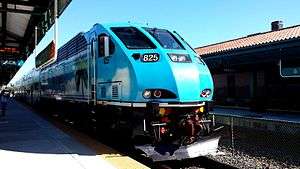Brookville BL36PH
| Brookville BL36PH | |||||||||||||||||||||||||||||||||||||||
|---|---|---|---|---|---|---|---|---|---|---|---|---|---|---|---|---|---|---|---|---|---|---|---|---|---|---|---|---|---|---|---|---|---|---|---|---|---|---|---|
|
A BL36PH in service for Tri-Rail | |||||||||||||||||||||||||||||||||||||||
| |||||||||||||||||||||||||||||||||||||||
| |||||||||||||||||||||||||||||||||||||||
| |||||||||||||||||||||||||||||||||||||||
The Brookville BL36PH is a four-axle diesel-electric locomotive for commuter trains, designed by Brookville Equipment Corporation.[2] It is built with an MTU 20V4000 V20 engine rated at 3,619 horsepower (2,699 kW) to meet EPA Tier 3 emissions standards.[2] It was the first North American passenger locomotive designed with a 20-cylinder engine since the EMD SDP45 and EMD FP45, originally built in the 1960s.[3] Head end power is generated by a separate, smaller diesel (Caterpillar C-18) gen-set and is rated at 500 kW (670 hp). The outer shell of the locomotive has been designed by Cesar Vergara,[2] who has also designed the outer shells of several other North American passenger locomotives, including the MPXpress and the EMD F59PHI.[4]
Tri-Rail, a Florida commuter rail service operated by the South Florida Regional Transportation Authority, is the launch customer,[2] with an initial order for 10 locomotives and later an option order of 2 more locomotives. The order had an option for 17 additional (now 15) locomotives,[2] up to four of which may be sold to Sound Transit,[5] operator of Sounder commuter rail service in Washington.
References
- ↑ "Detail: MTU Online". MTU. Retrieved 6 October 2015.
- 1 2 3 4 5 "Brookville Equipment gets SRFTA order". RailwayAge Magazine. 1 March 2011. Archived from the original on 15 July 2011. Retrieved 2 March 2011.
- ↑ Guss, Chris (November 2015). "20 cylinders and passenger trains". Trains. 75 (11): 22.
- ↑ "Motive Power Projects". Vergara Studio. Retrieved 9 March 2011.
- ↑ "SFRTA approves locomotive purchase for Tri-Rail". Progressive Railroading. 2 March 2011. Retrieved 3 March 2011.
External links
-
 Media related to Brookville BL36PH locomotives at Wikimedia Commons
Media related to Brookville BL36PH locomotives at Wikimedia Commons - "Press release and artist's rendering - 'Brookville to supply Tri-Rail with new locomotives'". Brookville Equipment Corporation. Archived from the original on 8 July 2011. Retrieved 3 March 2011.
- Specification Sheet
- Tractive effort curve on page 9.
